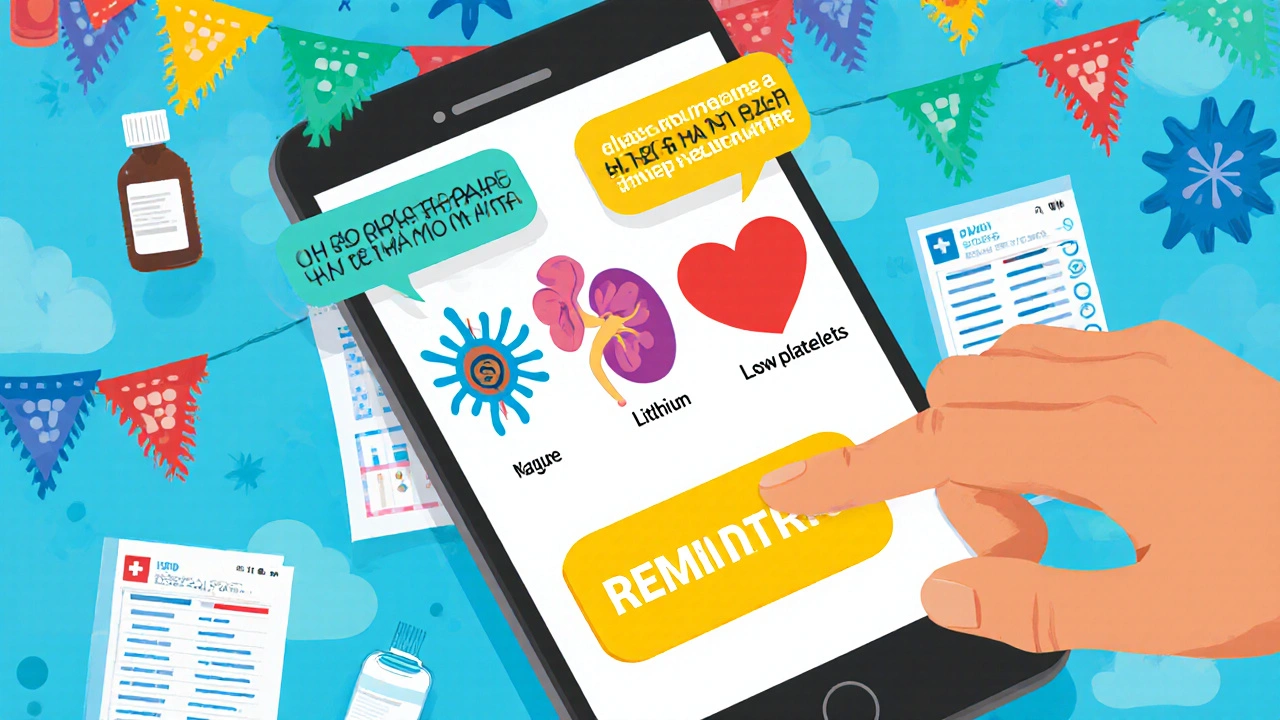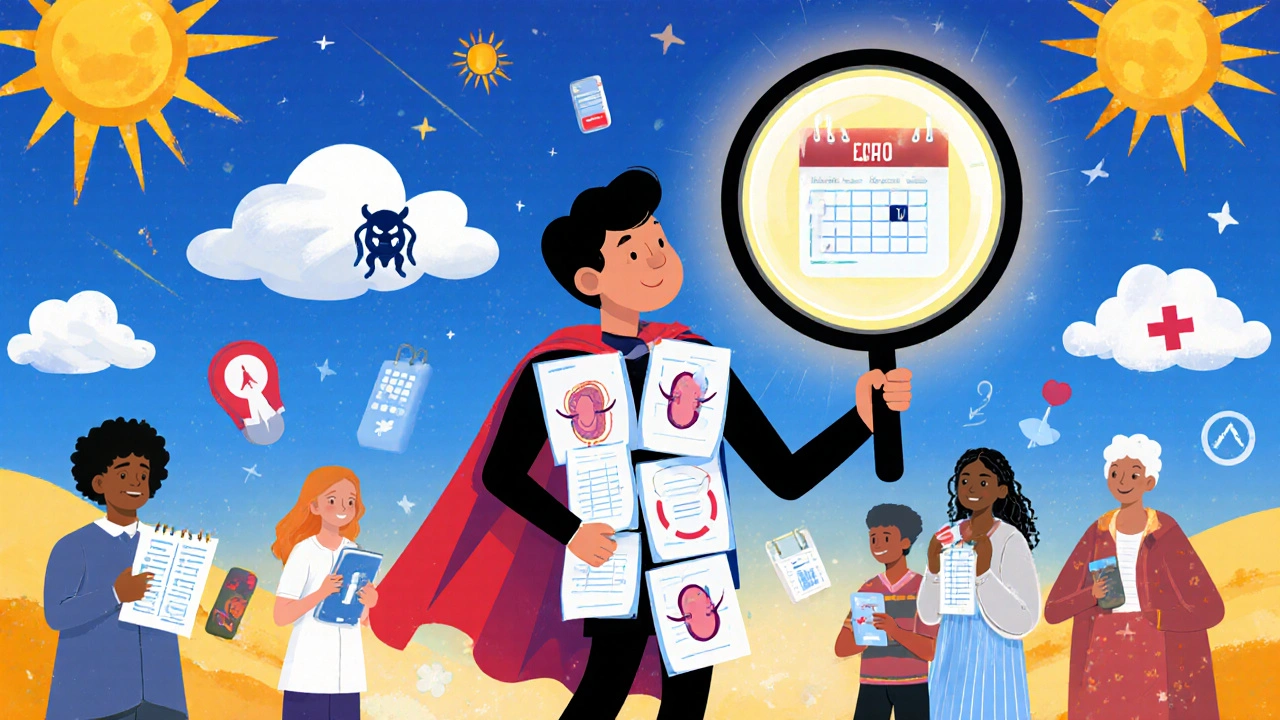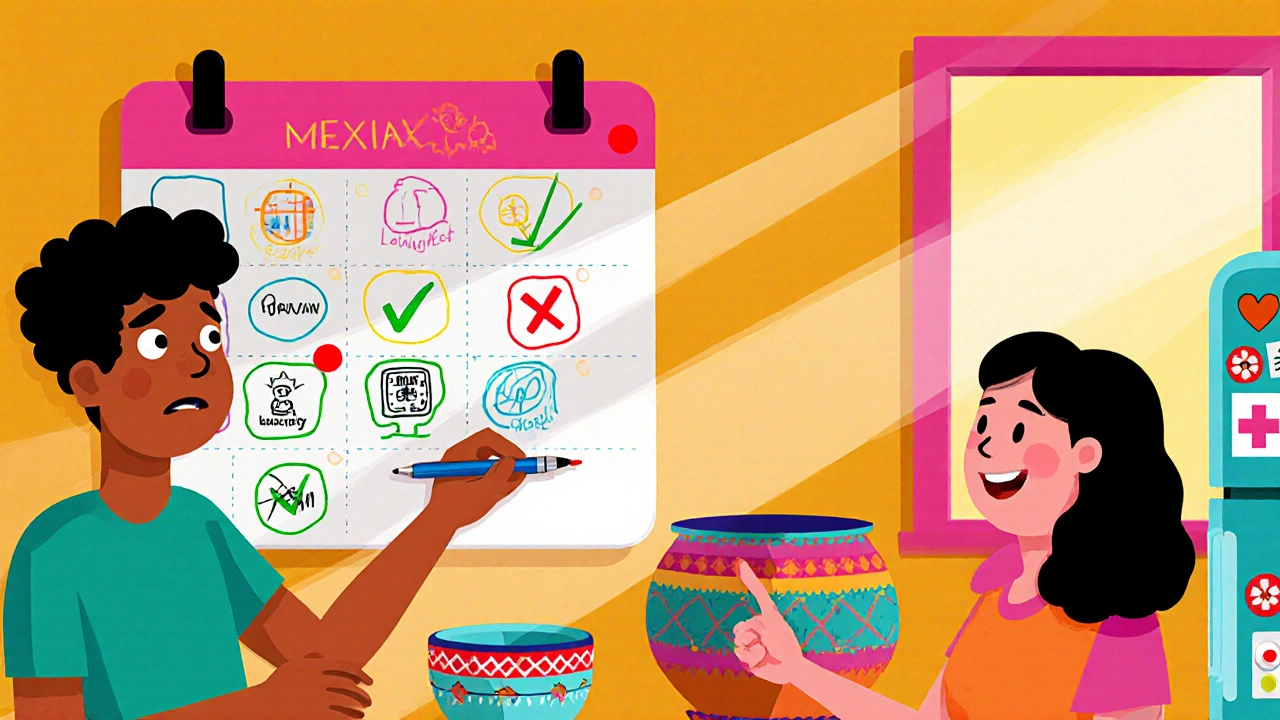Lab Monitoring Calendar Generator
Create Your Personalized Monitoring Schedule
Select your medication and get a custom calendar with recommended testing dates. This tool helps you stay on track with critical lab monitoring requirements.
Medication Details
Select a medication to see its monitoring requirements.
Important: This is a basic monitoring schedule. Always follow your doctor's specific instructions.
Your Monitoring Calendar
| Date | Test/Activity | Notes |
|---|
Symptom Tracking
Log any symptoms you experience. Note date, symptoms, and medication timing. This helps your doctor identify patterns.
Why Lab Monitoring Calendars Save Lives
Think about the last time you started a new medication. Maybe it was for depression, high blood pressure, or cancer. You got the prescription, filled it, and took your first pill. But what happened after that? Did you know exactly when to get your blood drawn? When to check your weight? When to call your doctor if something felt off? If you didn’t, you’re not alone. Many people don’t realize that lab monitoring calendars aren’t just paperwork-they’re your early warning system against dangerous side effects.
Some drugs are powerful. They work by changing how your body functions. But that power comes with risk. Too much lithium can poison your kidneys. Too little clozapine can mean your schizophrenia isn’t controlled. And if your INR drops too low on warfarin, you could have a stroke. These aren’t hypotheticals. They happen every day-not because the drugs are bad, but because monitoring got dropped.
A lab monitoring calendar isn’t a suggestion. It’s a medical necessity for certain medications. It’s a simple, structured way to track blood tests, physical symptoms, and vital signs so problems are caught before they become emergencies.
Who Needs a Lab Monitoring Calendar?
Not everyone needs one. But if you’re on any of these, you absolutely do:
- Clozapine (for treatment-resistant schizophrenia): Requires weekly blood tests for absolute neutrophil count (ANC) until levels stabilize. If ANC drops below 500/μL, you could develop life-threatening infections.
- Lithium (for bipolar disorder): Needs serum level checks 5-7 days after starting, then weekly until stable. After that, every 6 months-but only if you’re consistent. Levels change with hydration, salt intake, and kidney function.
- Warfarin (blood thinner): Monthly INR tests are standard. But if you start a new antibiotic, change your diet, or miss a dose? You might need weekly checks for a while.
- Systemic corticosteroids (like prednisone for more than 2 weeks): Can shut down your adrenal glands. A morning cortisol test before stopping is required to avoid adrenal crisis.
- LONSURF (for advanced colon cancer): Demands weekly blood counts to watch for low white cells, platelets, and hemoglobin. Gastrointestinal side effects like diarrhea and nausea also need daily logging.
- Glaucoma eye drops (like dorzolamide/timolol): Annual eye exams are needed to check for corneal damage and pressure changes.
Some meds need minimal monitoring-like mirtazapine, which only requires weekly weight and appetite checks for 4-8 weeks. Others? Lifelong tracking. Clozapine patients often need ANC tests for years, even if they’ve been stable for a decade. Skipping one test can be dangerous.
How to Build Your Own Lab Monitoring Calendar
You don’t need a fancy app to start. But you do need structure. Here’s how to build one that works:
- Get the official schedule from your doctor or pharmacist. Don’t guess. Ask: “What labs do I need, how often, and when?” Write it down.
- Choose your format. Use a printable PDF (like those from Community Behavioral Health), a digital calendar (Google or Apple), or an app like Blood Cancer United’s Health Manager. The key is consistency.
- Link tests to medication timing. Lithium levels must be checked 12 hours after your last dose. If you take it at 8 PM, your blood draw should be at 8 AM. Mark that on your calendar.
- Add symptom tracking. Not just labs. Note: fatigue, dizziness, rash, diarrhea, weight gain, mood shifts. Write them down the same day. Patterns matter.
- Set reminders. Use phone alerts, sticky notes, or calendar notifications. Don’t rely on memory. If your test is due on the 15th, set a reminder for the 12th.
- Bring it to every appointment. Your doctor doesn’t remember your last INR. You do. Show them your calendar. It’s your medical record.
Some tools make this easier. The LONSURF treatment calendar generator creates personalized sheets with space for daily temperature, side effects, and missed doses. Ulta Lab Tests lets you order blood panels online-but you still need a provider to interpret results and tell you when to test.

Digital vs. Paper: Which Works Better?
There’s no one-size-fits-all. But here’s what actually works for real people:
| Tool Type | Pros | Cons |
|---|---|---|
| Printable PDFs (e.g., CBH Philly) | Easy to print, no tech needed, great for older adults | No reminders, can’t track trends, easy to lose |
| Digital apps (e.g., Health Manager) | Sets reminders, links symptoms to meds and food, stores history | Requires smartphone, some cost money, not all sync with EHR |
| EHR-integrated systems | Auto-schedules tests, alerts provider if missed, connects to lab results | Only available through certain clinics, not patient-controlled |
| Phone calendar + notes | Free, always accessible, customizable | No built-in prompts for symptoms, easy to forget to update |
Patients who use digital tools with symptom logging report fewer hospital visits. Why? Because they catch early warning signs-like a slow drop in platelets or increasing fatigue-that they might ignore on paper.
What Happens When You Skip a Test?
Let’s be clear: skipping a lab test isn’t just “forgetting.” It’s gambling with your health.
- Missing an INR check on warfarin? Risk of stroke or internal bleeding doubles.
- Not testing lithium levels for 9 months? Toxicity can cause tremors, confusion, kidney damage-sometimes irreversible.
- Skipping ANC checks on clozapine? Neutropenia can turn into agranulocytosis in days. Emergency hospitalization. Possible death.
- Stopping prednisone without a cortisol test? Adrenal crisis. Low blood pressure, vomiting, coma.
These aren’t rare cases. Studies show over 40% of clozapine-related hospitalizations are linked to missed ANC monitoring. Warfarin-related bleeds are the #1 cause of emergency visits for people on blood thinners-and most are preventable.
Doctors can’t catch everything. You’re the one taking the pill every day. You’re the one feeling the side effects. You’re the one who sees the pattern: “Every time I take this, I get dizzy the next morning.” That’s data. Write it down.
When to Update Your Calendar
Your calendar isn’t set in stone. It needs updates:
- When your dose changes-even a small increase or decrease. Lithium levels shift fast. Clozapine monitoring frequency changes based on ANC trends.
- When you start a new med-antibiotics, supplements, even OTC painkillers can interfere. Warfarin reacts with ibuprofen. Lithium reacts with NSAIDs.
- When you change your diet-sudden salt intake affects lithium. Vitamin K-rich foods change warfarin’s effect.
- When you feel off-even if you think it’s “just stress.” Fatigue, bruising, confusion, or swelling? Add it to your calendar and show your doctor.
One patient on clozapine reduced her weekly ANC tests to monthly after 6 months of stable counts. But when she got the flu and stopped eating for 3 days, her ANC dropped. She didn’t test because she thought she was “off the schedule.” She ended up in the ER. Her calendar didn’t update for illness. That’s the gap.

Pro Tips for Sticking to Your Schedule
- Pair it with a habit. Do your blood draw right after your morning coffee. Or log symptoms while you eat dinner.
- Use color coding. Red for urgent tests, yellow for symptoms, green for stable. Makes it visual.
- Get a buddy. Ask a family member to remind you. Text them: “Test day today-can you check in?”
- Don’t wait for the doctor to ask. Bring your calendar to every visit. Say: “Here’s what I’ve tracked. Any changes?”
- Keep backups. Take a photo of your paper calendar. Save digital copies in two places.
One man on warfarin kept his calendar on his fridge with magnets. Every time he got a result, he stuck it on the board. His wife could see the trend. When INR spiked, she called the clinic before he even felt symptoms. He’s been stable for 7 years.
What’s Next for Lab Monitoring?
The future is smarter-but not necessarily more complicated.
Apps are starting to sync with wearables. If your smartwatch detects a sudden drop in heart rate variability, it could flag a possible lithium toxicity risk. AI tools are being tested to predict when a patient’s ANC might crash based on past trends, diet, and sleep patterns.
But right now, the most powerful tool is still the one you hold in your hand-or keep on your phone. A calendar. A checklist. A record of your body’s signals.
Medications save lives. But without monitoring, they can also end them. Your calendar isn’t extra work. It’s your safety net.
Frequently Asked Questions
Do I really need a lab monitoring calendar if I feel fine?
Yes. Many dangerous side effects-like low white blood cells from clozapine or lithium toxicity-don’t cause symptoms until they’re severe. By the time you feel dizzy or fatigued, your levels may already be in the danger zone. A calendar catches problems before you feel them.
Can I just rely on my doctor to remind me?
No. Doctors see dozens of patients a day. They may not remember your exact schedule, especially if you’ve been stable for months. Your calendar is your responsibility-and your protection. Even if your clinic sends reminders, keep your own record. It’s your health.
What if I miss a lab test?
Don’t panic, but don’t ignore it. Call your provider immediately. Some tests can be rescheduled without harm. Others-like clozapine ANC or lithium levels-need to be done within a specific window. Missing one doesn’t mean you’re in danger yet, but it increases risk. Get it done as soon as possible and update your calendar.
Can I use a generic calendar app or do I need a special one?
You can use any calendar app-Google Calendar, Apple Calendar, even a paper notebook. What matters is consistency and detail. But if you’re on a complex regimen like LONSURF or clozapine, apps like Blood Cancer United’s Health Manager let you link symptoms to medication times and food, which helps your doctor spot patterns you might miss.
How often should I review my calendar with my doctor?
Bring it to every appointment-whether it’s every 2 weeks or every 6 months. Even if you think everything’s fine, your doctor needs to see the trend. A slow drop in platelets over 3 months is more important than one low number. Your calendar turns scattered symptoms into a story your doctor can act on.
Are lab monitoring calendars only for serious illnesses?
No. While they’re critical for high-risk drugs like clozapine or warfarin, even common medications like thyroid pills or statins can need occasional monitoring. If your doctor says “we’ll check your labs in 3 months,” that’s a cue to add it to your calendar. It’s not just for cancer or psychosis-it’s for anyone on long-term medication.


Comments (15)
Gordon Mcdonough
I swear if one more person tells me to "just use a calendar" I'm gonna scream. My doctor gave me a 12-page PDF and said "print this" like I'm 70. I use Google Keep on my phone and I still forget. I got hospitalized last year because I missed my lithium check. I was fine until I wasn't. Now I have kidney damage and a $12k bill. Calendars don't fix laziness.
Kiran Mandavkar
Ah, the modern paradox: we are drowning in data yet starved of wisdom. The calendar is not the solution-it is merely the symptom of a healthcare system that outsources responsibility to the patient while charging them for the privilege of survival. We have reduced the sacred covenant of care to a checklist. The real question: Who benefits when the sick become their own nurses?
Eric Healy
Lithium levels change with salt intake? That’s wild. I didn’t know you could mess up your meds just by eating chips. My aunt took her meds with a beer and ended up in the psych ward. She thought "it’s just one drink". Idiot. You don’t play roulette with your brain.
Shannon Hale
I used to think I was fine until I started tracking my symptoms. Then I realized I’d been having panic attacks every Tuesday for 8 months and blamed it on "work stress". My calendar showed a pattern: every time I took my Zoloft on an empty stomach, I’d feel like I was dying. I started eating a banana first. No more panic. My doctor didn’t even ask about my eating habits. I had to figure it out myself. This isn’t healthcare-it’s a scavenger hunt for your own survival.
Holli Yancey
I appreciate this post so much. I’ve been on warfarin for 5 years and I use a paper calendar with colored stickers. My husband checks it every morning. We don’t have a fancy app, but we have each other. It’s not about the tool-it’s about showing up. Even on days when I’m tired or mad at the system, I write it down. Because I’m still here, and I don’t want to risk not being.
Leslie Douglas-Churchwell
The FDA knows this. They’ve been pushing these calendars for decades. But why? Because Big Pharma doesn’t want you to know that 73% of adverse drug events are preventable with basic tracking. They profit when you get sick. They profit when you get hospitalized. They profit when you need more meds to fix the meds. Your calendar is the only thing standing between you and a corporate profit margin. Don’t be fooled.
shubham seth
Let’s be real-this whole system is a joke. You need a PhD to manage your own meds. I’m on 5 drugs, 3 supplements, and a blood thinner. I track everything. I’ve got spreadsheets, reminders, color-coded notes. And yet? My doctor still didn’t catch that my INR spiked because I started eating kale. I had to Google it myself. This isn’t medicine. It’s a survival simulation game with no cheat codes.
Kathryn Ware
I started using the Blood Cancer United app after my mom passed from an undetected lithium toxicity. She was 68, didn’t have a smartphone, and thought "if I feel okay, I’m fine." I cried for weeks. Now I log everything-meds, mood, meals, even how much water I drink. I’ve got a 10-month streak. I’m not cured. But I’m alive. And I’m not letting anyone else slip through the cracks. You’re not alone. I’ve been there. You’ve got this. 💪❤️
kora ortiz
Stop waiting for permission to protect yourself. Your doctor doesn’t own your health-you do. If they say "monthly" but you feel weird? Test it. If they say "no need" but you’re dizzy? Log it. You’re not being difficult. You’re being smart. I started tracking my prednisone side effects and caught adrenal fatigue before it turned into a crisis. Now I bring my calendar to every visit like it’s my resume. And guess what? They listen.
Jeremy Hernandez
This whole post feels like a PSA from a hospital that doesn’t pay its staff enough to actually talk to patients. I’ve been on clozapine for 8 years. I’ve had 4 different doctors. NONE of them ever explained why I needed weekly blood tests. I found out from a Reddit thread. I’m not mad-I’m just tired. The system is broken. Your calendar won’t fix it. But at least you’ll know you’re not crazy for feeling like you’re fighting for your life every day.
Tarryne Rolle
Who decided that patients should be responsible for their own medical monitoring? Was it the doctors? The nurses? Or the insurance companies who don’t want to pay for follow-ups? We’ve turned healthcare into a DIY project. You’re not lazy for forgetting. You’re just human. And yet, we punish you for it with hospital bills and death. This isn’t empowerment. It’s neglect dressed up as responsibility.
Kyle Swatt
I used to think monitoring was about control. Then I got sick. Really sick. And I realized-it’s not about control. It’s about listening. Your body is whispering. The calendar? It’s the translator. I used to ignore fatigue. Now I write it down. I used to think dizziness was "just stress." Now I see it as a signal. I don’t fix my meds. I don’t fix my body. I just pay attention. And that’s enough.
Deb McLachlin
The data presented here is compelling and aligns with clinical guidelines from the American Psychiatric Association and the American College of Cardiology. However, the implementation of patient-driven monitoring remains inconsistent across socioeconomic strata. Digital tools are inaccessible to elderly, low-income, and rural populations. A one-size-fits-all approach is ethically untenable. We require subsidized, accessible, and culturally competent monitoring systems-not individualized burden.
saurabh lamba
I read this whole thing. Honestly? Kinda boring. I just take my pills. If I feel weird, I go to the ER. Done. Why make it harder?
Jessica Healey
I forgot my lithium test. I didn’t feel anything. I thought I was fine. Then I woke up shaking, couldn’t walk, and my vision blurred. My husband called 911. I was in the ER for 3 days. My blood level was 2.1. Toxic. They said if I’d waited another 24 hours, I could’ve been brain dead. I’m not scared of meds anymore. I’m scared of forgetting. Now I have alarms. 3 of them. Every day. No excuses.